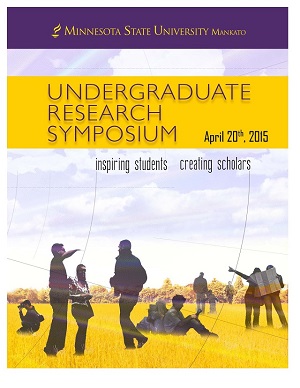Geochemical Fingerprinting of Glacial Sediments in Southern Minnesota
Location
CSU Ballroom
Start Date
20-4-2015 2:00 PM
End Date
20-4-2015 3:30 PM
Student's Major
Chemistry and Geology
Student's College
Social and Behavioral Sciences
Mentor's Name
Chad Wittkop
Mentor's Email Address
chad.wittkop@mnsu.edu
Mentor's Department
Chemistry and Geology
Mentor's College
Science, Engineering and Technology
Description
The intentions of this project are to advance the ongoing study of glacial sediment by developing chemical sediment fingerprints that could aid in the study of water quality of local rivers. To do this, glacial till samples were taken from various locations and analyzed using the XRF ( X-ray fluorescence spectrometer) to determine the chemical make-up of each till unit which will aid in determining chemical correlations between different tills in the region. After the tills were correlated, we were able to determine the source areas for each unit and determine the chemical compositions of the water within the rivers that they flow to. These results will help us determine what the source area of the sediment is and how those sediments affect the quality of the river water. A better understanding of the river water quality could help protect aquatic life of the rivers and the environment as a whole. This research is also being used to help strengthen the general knowledge of glacial sediment studies. Future benefits of this work may include developing chemical screening procedures for natural pollutants such as arsenic and sulfur in newly drilled groundwater wells.
Geochemical Fingerprinting of Glacial Sediments in Southern Minnesota
CSU Ballroom
The intentions of this project are to advance the ongoing study of glacial sediment by developing chemical sediment fingerprints that could aid in the study of water quality of local rivers. To do this, glacial till samples were taken from various locations and analyzed using the XRF ( X-ray fluorescence spectrometer) to determine the chemical make-up of each till unit which will aid in determining chemical correlations between different tills in the region. After the tills were correlated, we were able to determine the source areas for each unit and determine the chemical compositions of the water within the rivers that they flow to. These results will help us determine what the source area of the sediment is and how those sediments affect the quality of the river water. A better understanding of the river water quality could help protect aquatic life of the rivers and the environment as a whole. This research is also being used to help strengthen the general knowledge of glacial sediment studies. Future benefits of this work may include developing chemical screening procedures for natural pollutants such as arsenic and sulfur in newly drilled groundwater wells.
Recommended Citation
Scheeler, Daniel. "Geochemical Fingerprinting of Glacial Sediments in Southern Minnesota." Undergraduate Research Symposium, Mankato, MN, April 20, 2015.
https://cornerstone.lib.mnsu.edu/urs/2015/poster_session_B/20



